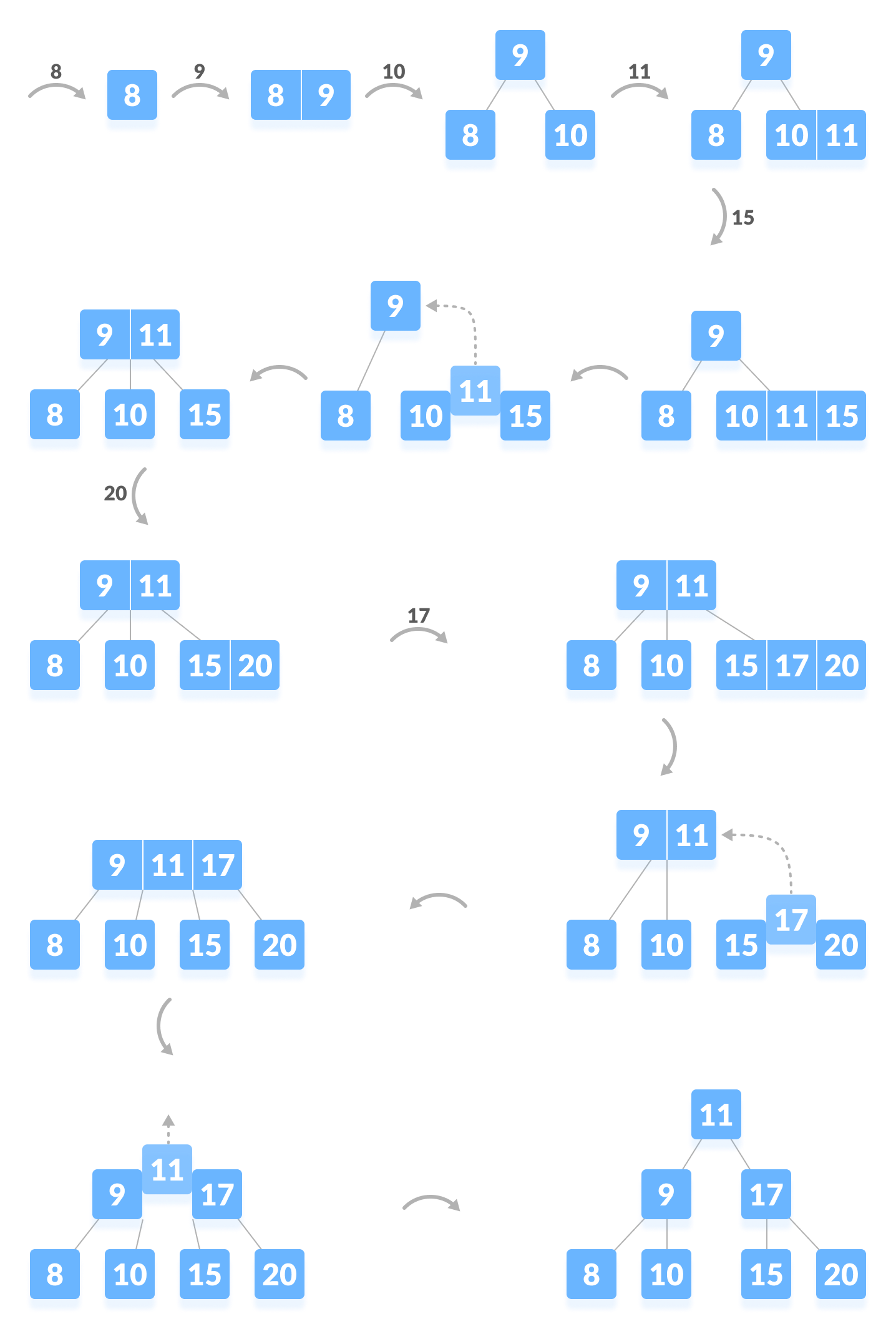Insertion into a B-tree
In this tutorial, you will learn how to insert a key into a btree. Also, you will find working examples of inserting keys into a B-tree in Python.
Inserting an element on a B-tree consists of two events: searching the appropriate node to insert the element and splitting the node if required.Insertion operation always takes place in the bottom-up approach.
Let us understand these events below.
Insertion Operation
- If the tree is empty, allocate a root node and insert the key.
- Update the allowed number of keys in the node.
- Search the appropriate node for insertion.
- If the node is full, follow the steps below.
- Insert the elements in increasing order.
- Now, there are elements greater than its limit. So, split at the median.
- Push the median key upwards and make the left keys as a left child and the right keys as a right child.
- If the node is not full, follow the steps below.
- Insert the node in increasing order.
Insertion Example
Let us understand the insertion operation with the illustrations below.
The elements to be inserted are 8, 9, 10, 11, 15, 16, 17, 18, 20, 23.

Algorithm for Inserting an Element
BreeInsertion(T, k)
r root[T]
if n[r] = 2t - 1
s = AllocateNode()
root[T] = s
leaf[s] = FALSE
n[s] <- 0
c1[s] <- r
BtreeSplitChild(s, 1, r)
BtreeInsertNonFull(s, k)
else BtreeInsertNonFull(r, k)
BtreeInsertNonFull(x, k)
i = n[x]
if leaf[x]
while i ≥ 1 and k < keyi[x]
keyi+1 [x] = keyi[x]
i = i - 1
keyi+1[x] = k
n[x] = n[x] + 1
else while i ≥ 1 and k < keyi[x]
i = i - 1
i = i + 1
if n[ci[x]] == 2t - 1
BtreeSplitChild(x, i, ci[x])
if k &rt; keyi[x]
i = i + 1
BtreeInsertNonFull(ci[x], k)
BtreeSplitChild(x, i)
BtreeSplitChild(x, i, y)
z = AllocateNode()
leaf[z] = leaf[y]
n[z] = t - 1
for j = 1 to t - 1
keyj[z] = keyj+t[y]
if not leaf [y]
for j = 1 to t
cj[z] = cj + t[y]
n[y] = t - 1
for j = n[x] + 1 to i + 1
cj+1[x] = cj[x]
ci+1[x] = z
for j = n[x] to i
keyj+1[x] = keyj[x]
keyi[x] = keyt[y]
n[x] = n[x] + 1Python Examples
/* Inserting a key on a B-tree in Python */
/* Create a node */
class BTreeNode:
def __init__(self, leaf=False):
self.leaf = leaf
self.keys = []
self.child = []
/* Tree */
class BTree:
def __init__(self, t):
self.root = BTreeNode(True)
self.t = t
/* Insert node */
def insert(self, k):
root = self.root
if len(root.keys) == (2 * self.t) - 1:
temp = BTreeNode()
self.root = temp
temp.child.insert(0, root)
self.split_child(temp, 0)
self.insert_non_full(temp, k)
else:
self.insert_non_full(root, k)
/* Insert nonfull */
def insert_non_full(self, x, k):
i = len(x.keys) - 1
if x.leaf:
x.keys.append((None, None))
while i >= 0 and k[0] < x.keys[i][0]:
x.keys[i + 1] = x.keys[i]
i -= 1
x.keys[i + 1] = k
else:
while i >= 0 and k[0] < x.keys[i][0]:
i -= 1
i += 1
if len(x.child[i].keys) == (2 * self.t) - 1:
self.split_child(x, i)
if k[0] > x.keys[i][0]:
i += 1
self.insert_non_full(x.child[i], k)
/* Split the child */
def split_child(self, x, i):
t = self.t
y = x.child[i]
z = BTreeNode(y.leaf)
x.child.insert(i + 1, z)
x.keys.insert(i, y.keys[t - 1])
z.keys = y.keys[t: (2 * t) - 1]
y.keys = y.keys[0: t - 1]
if not y.leaf:
z.child = y.child[t: 2 * t]
y.child = y.child[0: t - 1]
/* Print the tree */
def print_tree(self, x, l=0):
print("Level ", l, " ", len(x.keys), end=":")
for i in x.keys:
print(i, end=" ")
print()
l += 1
if len(x.child) > 0:
for i in x.child:
self.print_tree(i, l)
def main():
B = BTree(3)
for i in range(10):
B.insert((i, 2 * i))
B.print_tree(B.root)
if __name__ == '__main__':
main()Python Example for Beginners
Two Machine Learning Fields
There are two sides to machine learning:
- Practical Machine Learning:This is about querying databases, cleaning data, writing scripts to transform data and gluing algorithm and libraries together and writing custom code to squeeze reliable answers from data to satisfy difficult and ill defined questions. It’s the mess of reality.
- Theoretical Machine Learning: This is about math and abstraction and idealized scenarios and limits and beauty and informing what is possible. It is a whole lot neater and cleaner and removed from the mess of reality.
Data Science Resources: Data Science Recipes and Applied Machine Learning Recipes
Introduction to Applied Machine Learning & Data Science for Beginners, Business Analysts, Students, Researchers and Freelancers with Python & R Codes @ Western Australian Center for Applied Machine Learning & Data Science (WACAMLDS) !!!
Latest end-to-end Learn by Coding Recipes in Project-Based Learning:
Applied Statistics with R for Beginners and Business Professionals
Data Science and Machine Learning Projects in Python: Tabular Data Analytics
Data Science and Machine Learning Projects in R: Tabular Data Analytics
Python Machine Learning & Data Science Recipes: Learn by Coding
R Machine Learning & Data Science Recipes: Learn by Coding
Comparing Different Machine Learning Algorithms in Python for Classification (FREE)
Disclaimer: The information and code presented within this recipe/tutorial is only for educational and coaching purposes for beginners and developers. Anyone can practice and apply the recipe/tutorial presented here, but the reader is taking full responsibility for his/her actions. The author (content curator) of this recipe (code / program) has made every effort to ensure the accuracy of the information was correct at time of publication. The author (content curator) does not assume and hereby disclaims any liability to any party for any loss, damage, or disruption caused by errors or omissions, whether such errors or omissions result from accident, negligence, or any other cause. The information presented here could also be found in public knowledge domains.
Google –> SETScholars
